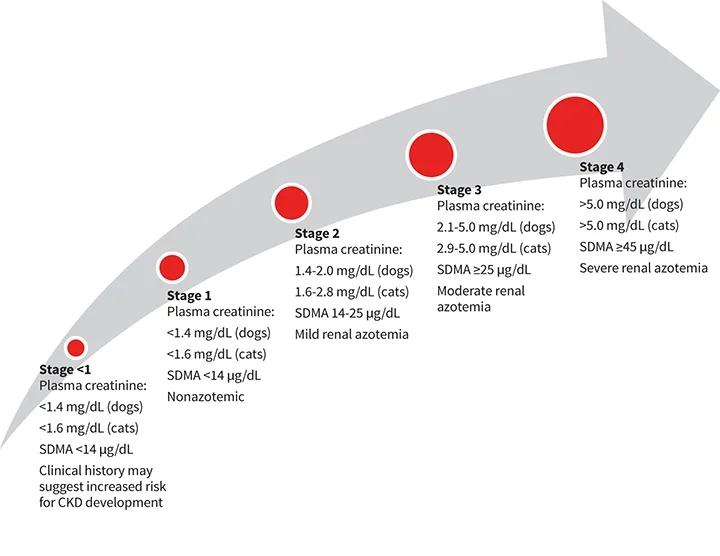Chronic Kidney Disease Staging in Dogs & Cats
David F. Senior, BVSc, DACVIM (SAIM), DECVIM-CA, Louisiana State University School of Veterinary Medicine

Overview
To promulgate standards of care for small animals, the International Renal Interest Society (IRIS) has established guidelines to diagnose, assess, and manage chronic kidney disease (CKD) in dogs and cats. The most recent versions can be found on the IRIS website (see Resources).
Diagnosing and staging CKD requires serum (from fasting blood) creatinine, a readily available diagnostic test, to infer glomerular filtration rate (GFR; see CKD Toolkit). GFR should be assessed on at least 2 occasions in a stable patient. Of note, alternative assessments of GFR (eg, symmetric dimethylarginine [SDMA]) may add to or supplant blood creatinine in the future.1 Important additional supportive information includes assessment of urinary concentrating ability (ie, urine specific gravity) without identifiable nonrenal cause, abnormal renal palpation or renal imaging findings, proteinuria of renal origin, and abnormal renal biopsy results.
Sounding Board
A Letter to the Editor: Staging for Chronic Kidney Disease in Dogs & Cats
SDMA, now available on commercial serum chemistry profiles, appears to enter the plasma at a constant rate, independent of muscle mass and dietary protein intake. SDMA is cleared by glomerular filtration alone, independent of urine volume. These characteristics suggest that SDMA may offer a more consistent indicator of GFR, less affected by confounding factors that impact both serum creatinine and blood urea nitrogen as indicators of kidney function and could allow earlier detection of CKD than traditional tests.2
The magnitude of proteinuria and degree of hypertension can provide further insight regarding the nature and likelihood of CKD progression and are incorporated as substages (see CKD Toolkit). Some breeds (eg, greyhounds) tend to have a higher normal range for blood pressure as compared with most other breeds.3
Staging can facilitate appropriate patient monitoring and treatment. IRIS has developed additional guidelines to address these elements (see Resources). These guidelines reinforce the value of repeating tests to make sure they accurately reflect patient status and regular patient reassessment to determine response to treatment, rate of CKD progression, and the need to adjust management strategies.
Resources
Several resources are available from IRIS to help diagnose, stage, and treat dogs and cats with CKD:
Diagnosis & Staging
IRIS has established algorithms for diagnosis and staging to accompany the staging criteria for dogs and cats (see Resources). The algorithms use standard, readily available test results to establish initial staging; however, substaging requires collection of urine for estimation of the urine protein:creatinine ratio and measurement of blood pressure. Blood pressure measurements can be inconsistent because of the requirement for special equipment and, most importantly, a standard technique.4
Treatment
IRIS staging can assist with development of empirical recommendations regarding appropriate, logical treatment for each CKD stage (see Resources). Predictions based on clinical experience might be made about the likely response to treatment.
Management strategies may include:
Discontinuing all potentially nephrotoxic drugs, if possible
Identifying and treating any pre- or postrenal abnormalities
Ruling out any treatable conditions (eg, pyelonephritis, renal urolithiasis)
Correcting dehydration
Reducing proteinuria (eg, low-protein diet, ACE inhibitors, angiotensin-receptor blockers)
Addressing systemic hypertension (eg, calcium channel blockers, ACE inhibitors)
Reducing dietary intake and GI absorption of phosphate
Correcting metabolic acidosis (usually only encountered in advanced Stage 3 and Stage 4)
Treating anemia (usually only encountered in advanced Stage 3 and Stage 4)
Reduced phosphate intake4 and reduction of proteinuria5-9 are the most important treatment strategies for reducing CKD progression. Patients in Stage 1 represent the best opportunity for intervention with these strategies to prevent or ameliorate CKD’s rate of progression.5-10 Correction of systemic hypertension, if present, is also important.11-14
Dogs and cats in Stages 1 through 3 often respond to appropriate management with improved longevity and slowing of progression,15 whereas those in Stage 4 tend to be fragile and much more prone to repeated episodes of uremic crises that require IV fluid support and renal replacement therapy (ie, dialysis) for restabilization.
IRIS Staging for the Medical Record
IRIS staging allows characterization of patient status in the medical record in a shorthand format that facilitates rapid recognition of status, disease progression, and response to treatment. For example*:
A feline CKD patient before treatment with a blood creatinine of 1.6 mg/dL (283 µmol/L), UP/C of 1.5, and systolic blood pressure of 230 mm Hg would be classified as:
IRIS CKD Stage 1, P (proteinuric), SH (severely hypertensive)
On follow-up after treatment with antihypertensive agents and strategies to reduce proteinuria, the cat returns with a blood creatinine of 2 mg/dL (353 µmol/L), UP/C of 0.4, and systolic blood pressure of 155 mm Hg and would be reclassified as:
IRIS CKD Stage 2, BP(T) (borderline proteinuric on treatment)
A canine CKD patient presented with a blood creatinine of 2.5 mg/dL (220 µmol/L), UP/C of 0.4, and systolic blood pressure of 165 mm Hg would be classified as:
IRIS CKD Stage 3, BP (borderline proteinuric), H (hypertensive)
On follow-up during administration of treatment to address both proteinuria and hypertension, the dog returns with a blood creatinine of 3.8 mg/dL (336 µmol/L), UP/C of <0.2, and systolic blood pressure of 145 mm Hg and would be reclassified as:
IRIS CKD Stage 3, NP(T) (nonproteinuric on treatment), NH(T) (nonhypertensive on treatment)
Conclusion
IRIS staging CKD patients can help improve patient assessment and outcome, promote timely implementation of treatment strategies, facilitate assessment of treatment effectiveness, and standardize the terminology of CKD patient status. Although adoption is likely far from universal, implementation in practice is encouraged.
*Examples are based on similar examples found on the IRIS website.
CKD Toolkit: Staging in Dogs & Cats
The following figures were adapted from information provided in the International Renal Interest Society (IRIS) guidelines1.

Chronic kidney disease staging in dogs & cats

Substaging based on proteinuria

Substaging based on blood pressure. Adjustments should be made for breeds with typically higher blood pressure.
CKD = chronic kidney disease, GFR = glomerular filtration rate, IRIS = International Renal Interest Society, SDMA = symmetric dimethylarginine, UP:C = urine protein:creatinine ratio